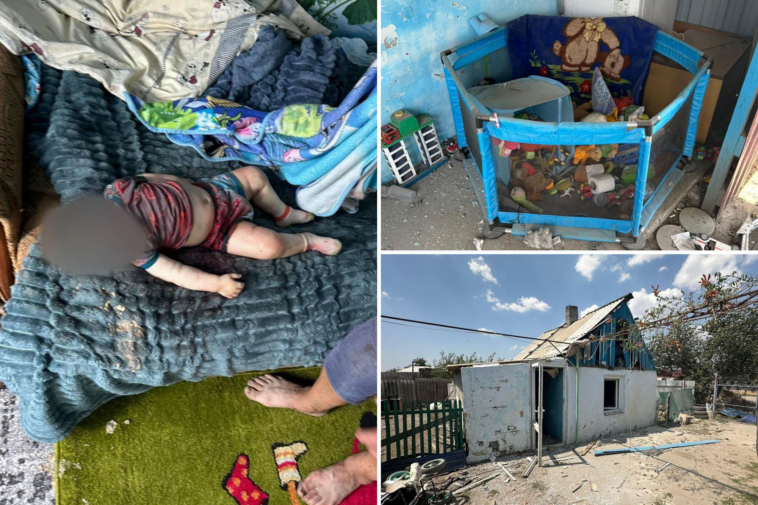A one-year-old boy was “mercilessly and deliberately” executed in a Russian drone attack in southern Ukraine — where terrified residents say they feel they are being hunted in a sick game of “human safari,”officials said.
Haunting images of the boy’s play room at his great-grandmother’s house in Pravdyne show glass and debris flung all over his toys following the deadly explosion.
“These children’s toys, scattered by the blast wave, belonged to Dmytryk,” Ukrainian senior military official Oleksandr Prokudin told The Telegraph.
“He was only one year-and-two-months old. Today, he was killed by Russia – mercilessly and deliberately,” he added.
Both Russia and Ukraine use “first person view” (FPV) drones, in which soldiers remotely fly the bomb-laden aircraft while viewing the footage live. The drones then crash into their targets and explode.
Russia has used such drones to terrorize the local population of Kherson — hunting civilians who are out in the open and detonating their deadly payload.
Kherson has been devastated by such attacks since the summer of 2024, with nearly 150 civilians killed and hundreds more injured, according to the United Nations.
Hundreds of these strikes were reported over the last year, along with attacks from grenades, landmines and other incendiary weapons, according to the New York City-based Human Rights Watch group.
“The drones send live video feeds back to their operators, who control the drones’ flight and use of weapons with deadly precision from up to 25 kilometers (15.5 miles) away,” the HRW’s June 2025 report found.
The HRW found that the drones used in the attacks are smaller quadcopters that allow for more maneuverability and precision, allowing Russian soldiers to aim at single human targets.
Many of the drones used in Kherson measure less than 16 inches and are operated using a smartphone or handheld-controller.
The human rights group documented at least 45 drone attacks in the villages of Antonivka and Dniprovskyi that appear to show the UAVs “deliberately” targeting civilians and civilian infrastructure.
One of the cases included video from Russian military-affiliated Telegram channels showing a 23-year-old mother of two being targeted by a drone while cycling near the Antonivka Bridge last September.
The drone could be seen chasing the panicked mother before dropping an explosive munition that hits just a few feet away from her, leaving the victim with a broken leg.
The United Nations, which found Russia guilty of crimes against humanity in Kherson over the drone attacks in May, recorded similar incidents.
One of the cases highlighted by the UN focused on a 45-year-old man who was riding a moped in the village of Stanislav last November when a drone hit him, badly injuring his leg.
Here is the latest on the Russia-Ukraine conflict
When an ambulance arrived to pick him up, another drone dropped two explosives on the emergency vehicle.
“The evidence collected leaves no doubt that the perpetrators intended to carry out these acts” the UN Human Rights Council said in a statement.
“The Commission therefore concludes that Russian armed forces perpetrated the war crime of intentionally directing attacks against civilians in Kherson Province. It also finds that posting videos of civilians being killed and injured amounts to the war crime of outrages upon personal dignity,” the agency added.
The frequency of the attacks led civilians to describe Kherson as a “human safari zone,” where they are hunted from the sky by the deadly Russian drones.
Kherson was the first major city captured by Russia after it launched its full-scale invasion of Ukraine in February 2022, with Kyiv soldiers engaging in a nine-month battle to liberate the city.
The Russian troops, however, repositioned their forces across the Dnieper River, where they began firing the deadly drone attacks.
The attacks in Kherson come as Russia has also escalated its drone bombardment across all of Ukraine, firing a record 728 UAVs and missiles on Tuesday night.
Moscow followed up the attack with more than 400 drones and 18 missiles overnight, killing two people in Kyiv.
Experts say the ever-escalating aerial attacks from Russia indicate that Moscow has completed its drone-manufacturing plants, where production is ramping up.
Christina Harward, a Russia analyst for the Washington-based Institute for the Study of War think tank, said the new Russian drones have been modified from the original Iranian Shahed version.
“We’re seeing decoy drones, which made up about half of last night’s assault, now equipped with actual warheads to keep the Ukrainians guessing,” Harward told The Post.
“Other drones are also being equipped with chemical weapons to cause damage even when they’re intercepted by Ukraine,” she added.



